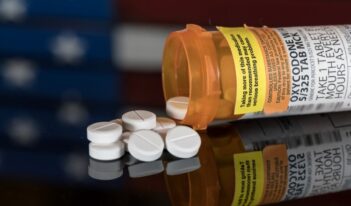
To curb overdoses and drug trafficking, the DEA proposes regulations for a chemical precursor to fentanyl.
Fentanyl, a synthetic opioid considered up to 100 times more deadly than morphine, remains the primary cause of overdose deaths in the United States. In recent years, fentanyl’s pervasiveness in the illegal drug market has more than tripled the national rate of opioid-related deaths.
To address the increase in fatal overdoses from fentanyl, federal drug regulators proposed a rule that would seek to limit the accessibility and availability of a chemical compound in fentanyl. This chemical compound, norfentanyl, completes the synthesis of fentanyl and is often used in illegal drug laboratories. The proposed rule would label norfentanyl as an immediate precursor to fentanyl and would regulate it under federal law.
Federal law classifies drugs into “schedules” based on their level of dangerousness, potential for abuse, and accepted use in medicine. Schedule II drugs, such as fentanyl, have a high risk of abuse and can result in dangerous psychological and physical dependence. In fact, fentanyl has become a highly trafficked drug in illegal markets because it has similar effects as heroin.
Despite its legitimate use in the medical field for anesthesia and pain management, norfentanyl is often used in illicit fentanyl production since it is unregulated, easily obtainable from chemical suppliers, and can create fentanyl in just a one-step chemical process. The U.S. Drug Enforcement Administration (DEA), the agency that regulates the manufacturing, supply, and use of drugs, has proposed to regulate norfentanyl, asserting that its control is essential to preventing illegal fentanyl manufacturing.
To prevent norfentanyl’s continued use in illegal markets, the proposed rule would designate norfentanyl as an immediate precursor to fentanyl.
An immediate precursor is a main chemical component that is used to create a controlled substance. Under federal law, immediate precursors require regulation “to prevent, curtail, or limit the manufacture of such controlled substance.” The DEA contends that norfentanyl meets this definition.
Regulatory designation of norfentanyl would require its lawful producers and suppliers to heighten the level of security they give to the chemical. This increased protection would create barriers for illegal manufacturers who attempt to steal norfentanyl, the DEA asserts.
Furthermore, the proposed rule would target individuals who sell unregulated norfentanyl to unlicensed fentanyl manufacturers by imposing sanctions on these illicit suppliers for violating the registration, security, and reporting requirements of controlled substances.
Norfentanyl’s designation as an immediate precursor to fentanyl would also enable the DEA to classify the substance as a schedule II drug. Drugs that are listed as immediate precursors undergo instant classification and do not require the DEA to follow the typical procedures to determine the placement of the substance within the schedule categories.
With both an immediate precursor and schedule II classification, norfentanyl would fall under federal regulations of production, supply, transactions, and shipping processes for schedule II drugs. These classifications would permit the DEA to enforce stricter administrative, civil, and criminal charges for violations of schedule II regulations.
Under schedule II drug laws, all individuals who manufacture, supply, administer, or conduct research using norfentanyl would be required to register with the DEA. These individuals would need to store, label, package, and transport norfentanyl in compliance with schedule II security guidelines. Schedule II quota and inventory reporting requirements would also apply to ensure accurate record-keeping of quantities of the drug.
The DEA recognizes that potential lawful holders of norfentanyl would face some additional costs due to these heightened security and reporting requirements. It reasons, however, that these legitimate manufacturers are likely registered under federal law for other drugs and should have compliance systems already in place. Additional costs related to scheduling norfentanyl would therefore be minimal for these registered individuals, the DEA concludes.
Although some registered producers would incur new expenses to secure norfentanyl, the DEA has found that the majority of norfentanyl production exists in illicit markets. Of the 30 identified U.S. suppliers of norfentanyl, the DEA estimates that 29 likely possess norfentanyl for reasons other than legitimate pharmaceutical purposes.
Since the proposed rule would focus on reducing fentanyl’s infiltration into illegal drug markets, most of the public comments submitted to the DEA on its proposed rule have expressed support for regulating norfentanyl.
One commentator, however, has noted that the proposed rule would serve as only one step in combatting illegal drug manufacturing since the rule would not reach the 22 foreign suppliers that ship norfentanyl to illegal domestic producers. Another commentator expressing similar concern stated that the proposed rule would not generate a substantial impact on the amount of fentanyl in illicit markets since most norfentanyl is sourced from international suppliers.
Several of these commentators advocate for stronger international enforcement of fentanyl’s immediate precursors, along with local public health initiatives such as safe injection sites, to reduce fentanyl-related deaths.
The DEA acknowledges that a variety of strategies are needed to combat fentanyl trafficking, confirming that this proposed rule would serve as one of many initiatives in the battle against clandestine drug manufacturing.
The agency has yet to publish a final rule, but perhaps it will incorporate some of the issues raised during the public comment period to curb the prevalence of fentanyl in the illegal drug trade.



